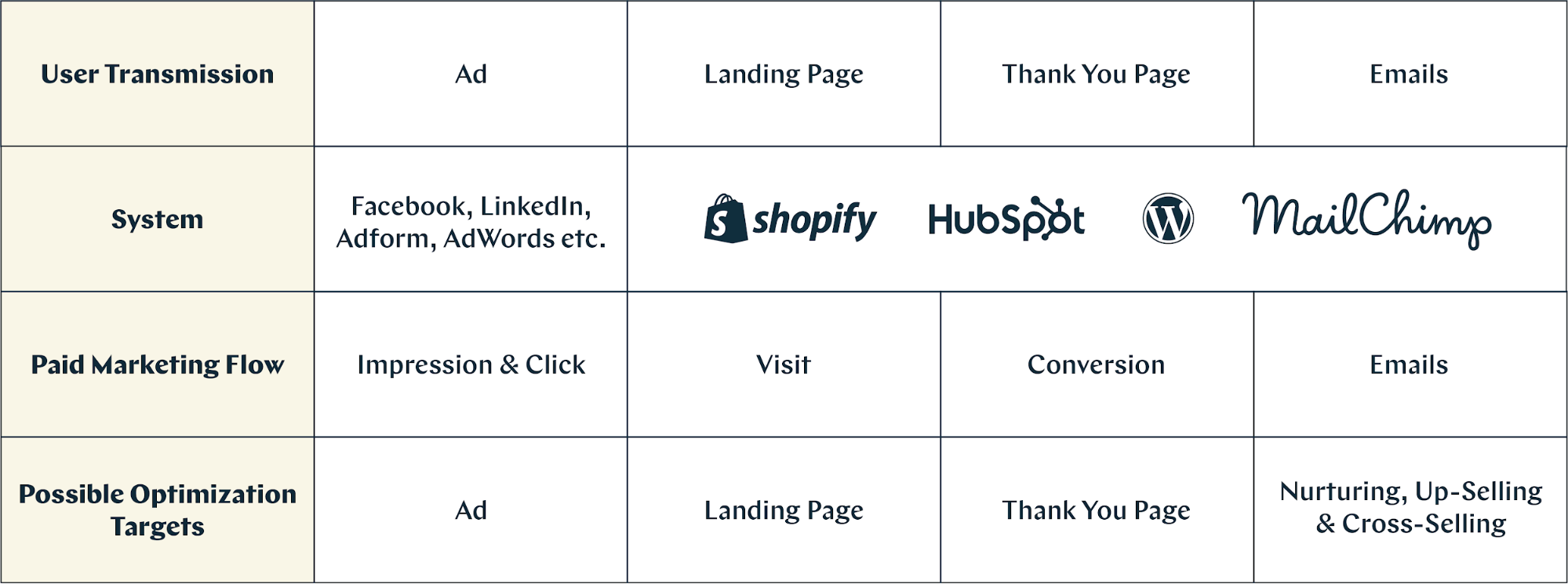The Data Handbook
How to use data to improve your customer journey and get better business outcomes in digital sales. Interviews, use cases, and deep-dives.
Get the bookWhat are conversions and why do they matter?
Conversions are a way to determine a certain goal or action that was fulfilled by a user on a given landing page. There are many levels or types of conversions. A conversion may well be someone downloading a checklist PDF from a blog article by submitting a form, or an actual purchase.
Depending on the goal of the marketing effort, conversions can either bring the company new leads or direct new sales. Conversions can, thereby, fall into different parts of the sales funnel: awareness, consideration, or decision also called as top-of-the funnel (TOFU), middle-of-the-funnel (MOFU), and bottom-of-the-funnel (BOFU) conversions. Take a look at what a growth hacking funnel for marketing can look like.
Depending on the goal, conversions can be given a value that allows you to assess the business impact any given conversion type has. Typically, more branding-oriented TOFU conversions are not as valuable for a business as closer-to-the-sales BOFU conversions. This is something to keep in mind when driving conversions; not all conversions are equal and should not be treated that way.
How to track conversions?
Conversions are typically verified with a thank you page on a given website. By placing tracking codes (i.e., so called global site tag and event snippet) onto the thank you page, information about a conversion occurrence can be transmitted to different systems, such as Google Analytics or Google Ads.
To set up different types of conversions, follow these instructions by Google. I do recommend you to use Google Tag Manager for implementing codes onto your website, as it is by far the easiest way to add and manage conversion tracking on your site.
Each platform where conversions are expected to happen needs to be set up individually. For Facebook, follow these guidelines for setting up conversion tracking, and for LinkedIn, you can follow these instructions. As apparent, each paid advertising platform needs its own conversion tracking setup, but when you have Google Tag Manager, you can manage all conversions from one place. Once tracking is in place and functional, paid advertising campaigns can be optimised towards conversions (i.e., campaign goal = conversions or CPA) on the campaign level.
How to optimise for conversions?
Conversion optimisation, or conversion rate optimisation (CRO) is a systematic process that aims to increase the amount of conversions and the percentage of visitors converting into leads or customers.
A/B testing is central when optimising for conversions. Especially in paid advertising, this means either running two alternative options side by side or conducting a split test to determine which version performs better.
In A/B testing, it is paramount that only one part is altered at a time. Thus, when changing—for instance—the heading copy or image of an ad, all other things should be kept unchanged. Alternatively, when changing the form or body text on the landing page, the ad elements should not be touched. You get the idea.
Importantly, colour, size, and font matters. You might be tweaking copy and visuals but forget to account for usability and user-friendliness. User experience (UX) as well as user interface (UI) are essential in conversion hacking, and those should not be bypassed or neglected by a marketer. Ultimately, a cross-functional approach to conversion optimisation is highly recommended.
This table here presents a simplified process of conversions in the case of paid advertising:
In ecommerce, the amount of conversions depends—besides the actual landing page—also on a multitude of other things, such as price, shopping cart, search and payment methods to name a few. Moreover, the checkout process should be made as easy and understandable as possible.
Make sure your landing page is simple and easy to use. A landing page should have only one main goal, and that is to drive conversions. Should you have other goals, consider producing alternative landing pages for those needs. Limiting access to navigation and footer (i.e., obstructing clicking elsewhere) is recommended in the case of content downloads for inbound marketing.
While the conversion occurrence is the goal, it is—by no means—the end point for a marketer. Actually, conversion should be seen only as an intermediate target that allows for the growing of the client account. Conversions—or customers—should, at this stage, be further categorised according to their buyer personas and use cases, or business impact (i.e., average order value and amount). In particular, those may be weighted and prioritised by their importance and business impact resulting in a tiered customer approach and a structured customer communications plan.
Regarding the content download or purchase form on the landing page, make sure you ask explicitly and in accordance with European GDPR rules the permission to approach these people with emails. Should you forget to do this, you will not have the opportunity to upsell or cross-sell with emails. Also, you lose the chance to nurture your leads towards purchasing.
Conversion optimisation checklist for online marketers
Keep these things in mind, when optimising for conversions:
As a starting point…
✓ Know your target audience or preferred target segment — download our buyer persona canvas
✓ Tailor your message accordingly throughout the buyer’s journey; design a specific “pitch” for each stage of the sales funnel — download our customer journey map
As for the actual conversion optimisation...
✓ Have one landing page per campaign goal
✓ Optimise the different elements of the ad
✓ Optimise the landing page elements
✓ Ask for marketing permissions on the form (GDPR)
✓ Consider selling more on the thank you page
✓ Nurture and grow the account for future conversions through emails
And most importantly, do not change everything at the same time. Change one thing at a time.
Happy conversion hunting!
Make growth opportunity ideation a continuous part of your business processes and learn to identify new opportunities with our free Growth Hacking Canvas. After you have filled in the canvas, you will have a much better understanding of where and how growth can be acquired in one particular customer group.
The Data Handbook
How to use data to improve your customer journey and get better business outcomes in digital sales. Interviews, use cases, and deep-dives.
Get the book




